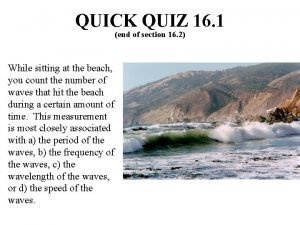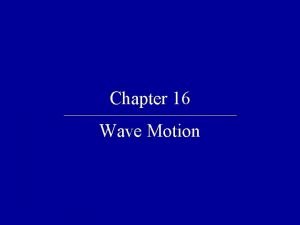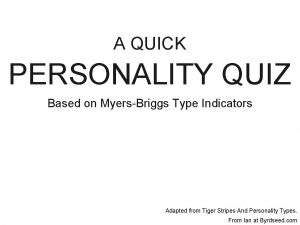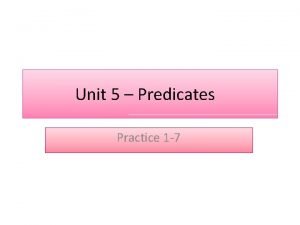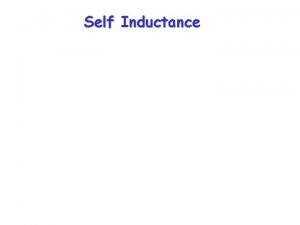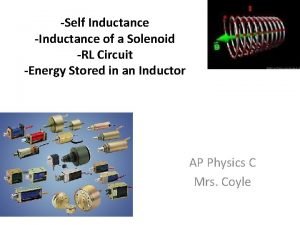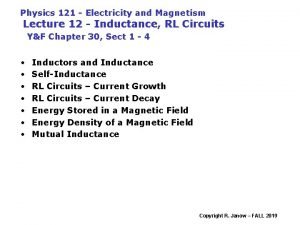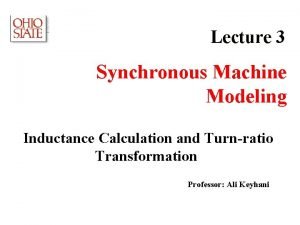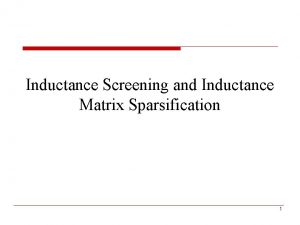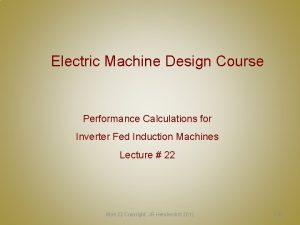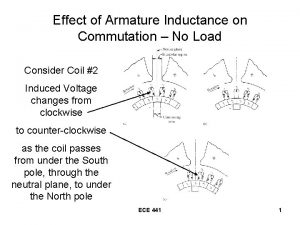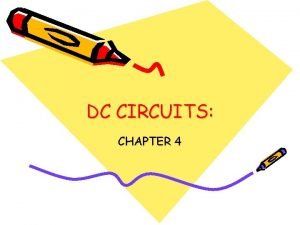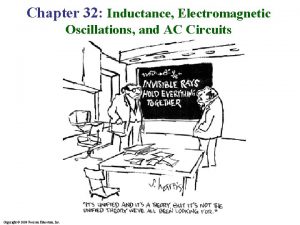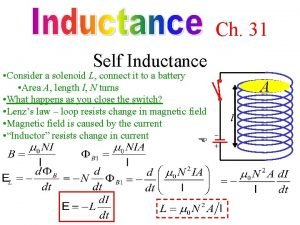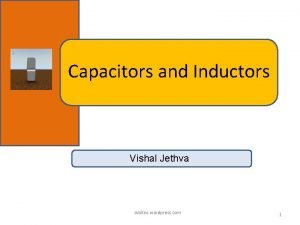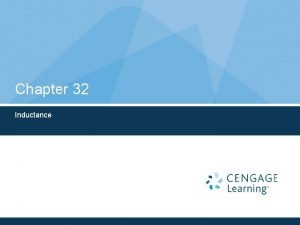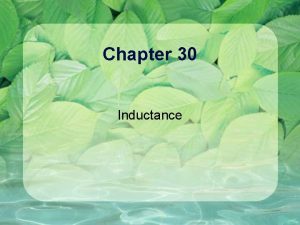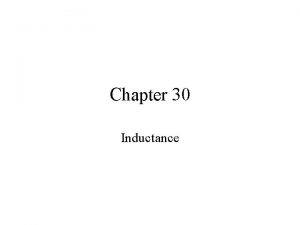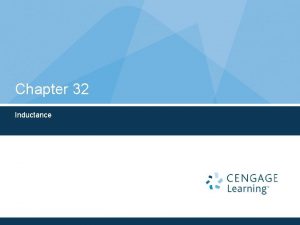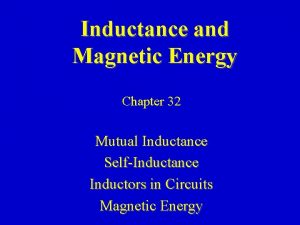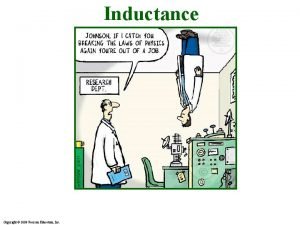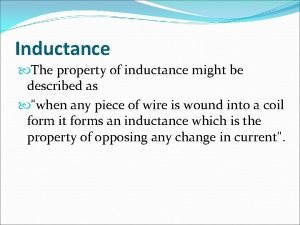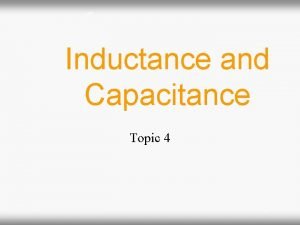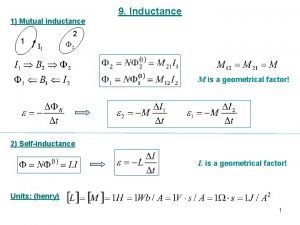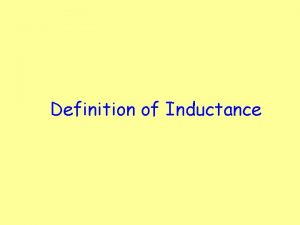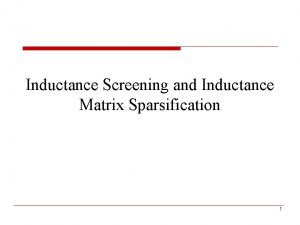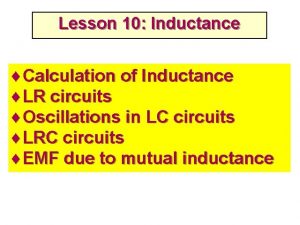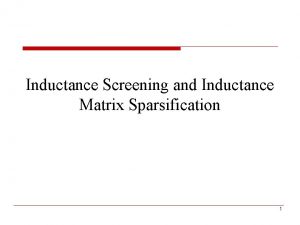Chapter 32 Inductance Quick Quiz 32 1 A



















- Slides: 19

Chapter 32 Inductance

Quick Quiz 32. 1 A coil with zero resistance has its ends labeled a and b. The potential at a is higher than at b. Which of the following could be consistent with this situation? (a) The current is constant and is directed from a to b (b) The current is constant and is directed from b to a (c) The current is increasing and is directed from a to b (d) The current is decreasing and is directed from a to b (e) The current is increasing and is directed from b to a (f) The current is decreasing and is directed from b to a

Quick Quiz 32. 1 Answer: (d), (e). For the constant current in (a) and (b), there is no potential difference across the resistanceless inductor. In (c), if the current increases, the emf induced in the inductor is in the opposite direction, from b to a, making b higher in potential than a. Similarly, in (f), the decreasing current induces an emf in the same direction as the current, from b to a, again making the potential higher at b than a.

Quick Quiz 32. 2 a The circuit in the figure below consists of a resistor, an inductor, and an ideal battery with no internal resistance. At the instant just after the switch is closed, across which circuit element is the voltage equal to the emf of the battery? (a) the resistor (b) the inductor (c) both the inductor and resistor

Quick Quiz 32. 2 a Answer: (b). As the switch is closed, there is no current, so there is no voltage across the resistor.

Quick Quiz 32. 2 b After a very long time, across which circuit element is the voltage equal to the emf of the battery? (a) the resistor (b) the inductor (c) both the inductor and resistor.

Quick Quiz 32. 2 b Answer: (a). After a long time, the current has reached its final value, and the inductor has no further effect on the circuit.

Quick Quiz 32. 3 The circuit in the figure below includes a power source that provides a sinusoidal voltage. Thus, the magnetic field in the inductor is constantly changing. The inductor is a simple air-core solenoid. The switch in the circuit is closed and the lightbulb glows steadily. An iron rod is inserted into the interior of the solenoid, which increases the magnitude of the magnetic field in the solenoid. As this happens, the brightness of the lightbulb: (a) increases (b) decreases (c) is unaffected

Quick Quiz 32. 3 Answer: (b). When the iron rod is inserted into the solenoid, the inductance of the coil increases. As a result, more potential difference appears across the coil than before. Consequently, less potential difference appears across the bulb, so the bulb is dimmer.

Quick Quiz 32. 4 Two circuits like the one shown in Figure 32. 6 are identical except for the value of L. In circuit A the inductance of the inductor is LA, and in circuit B it is LB. Switch S is thrown to position a at t = 0. At t = 10 s, the switch is thrown to position b. The resulting time rates of change for the two currents are as graphed in the figure below. If we assume that the time constant of each circuit is much less than 10 s, which of the following is true? (a) LA > LB (b) LA < LB (c) not enough information to tell

Quick Quiz 32. 4 Answer: (b). Figure 32. 10 shows that circuit B has the greater time constant because in this circuit it takes longer for the current to reach its maximum value and then longer for this current to decrease to zero after switch S 2 is closed. Equation 32. 8 indicates that, for equal resistances RA and RB, the condition B > A means that LA < LB.

Quick Quiz 32. 5 You are performing an experiment that requires the highest possible energy density in the interior of a very long solenoid. Which of the following increases the energy density? (More than one choice may be correct. ) (a) increasing the number of turns per unit length on the solenoid (b) increasing the cross-sectional area of the solenoid (c) increasing only the length of the solenoid while keeping the number of turns per unit length fixed (d) increasing the current in the solenoid

Quick Quiz 32. 5 Answer: (a), (d). Because the energy density depends on the magnitude of the magnetic field, to increase the energy density, we must increase the magnetic field. For a solenoid, B = 0 n. I, where n is the number of turns per unit length. In (a), we increase n to increase the magnetic field. In (b), the change in cross-sectional area has no effect on the magnetic field. In (c), increasing the length but keeping n fixed has no effect on the magnetic field. Increasing the current in (d) increases the magnetic field in the solenoid.

Quick Quiz 32. 6 In the figure below, coil 1 is moved closer to coil 2, with the orientation of both coils remaining fixed. Because of this movement, the mutual induction of the two coils (a) increases (b) decreases (c) is unaffected

Quick Quiz 32. 6 Answer: (a). M 12 increases because the magnetic flux through coil 2 increases.

Quick Quiz 32. 7 At an instant of time during the oscillations of an LC circuit, the current is at its maximum value. At this instant, the voltage across the capacitor (a) is equal to that across the inductor (b) is zero (c) has its maximum value (d) is impossible to determine

Quick Quiz 32. 7 Answer: (b). If the current is at its maximum value, the charge on the capacitor is zero.

Quick Quiz 32. 8 At an instant of time during the oscillations of an LC circuit, the current is momentarily zero. At this instant, the voltage across the capacitor (a) is equal to that across the inductor (b) is zero (c) has its maximum value (d) is impossible to determine

Quick Quiz 32. 8 Answer: (c). If the current is zero, this is the instant at which the capacitor is fully charged and the current is about to reverse direction.
 Quick find algorithm
Quick find algorithm The fan blade is speeding up. what are the signs of
The fan blade is speeding up. what are the signs of Section quiz 16-1
Section quiz 16-1 Quick quiz 16 answers
Quick quiz 16 answers Quick personality quiz
Quick personality quiz Unit 5 quick quiz 1
Unit 5 quick quiz 1 Magnetizing inductance
Magnetizing inductance Inductanta
Inductanta Energy in a solenoid
Energy in a solenoid Emf formula inductance
Emf formula inductance Magnetizing inductance
Magnetizing inductance Matrix sparsification
Matrix sparsification Imflux course
Imflux course Di/dt
Di/dt Armature inductance
Armature inductance Current and inductance relationship
Current and inductance relationship Schering bridge equation
Schering bridge equation Inductance units
Inductance units Inductors in series
Inductors in series Finding equivalent inductance
Finding equivalent inductance


